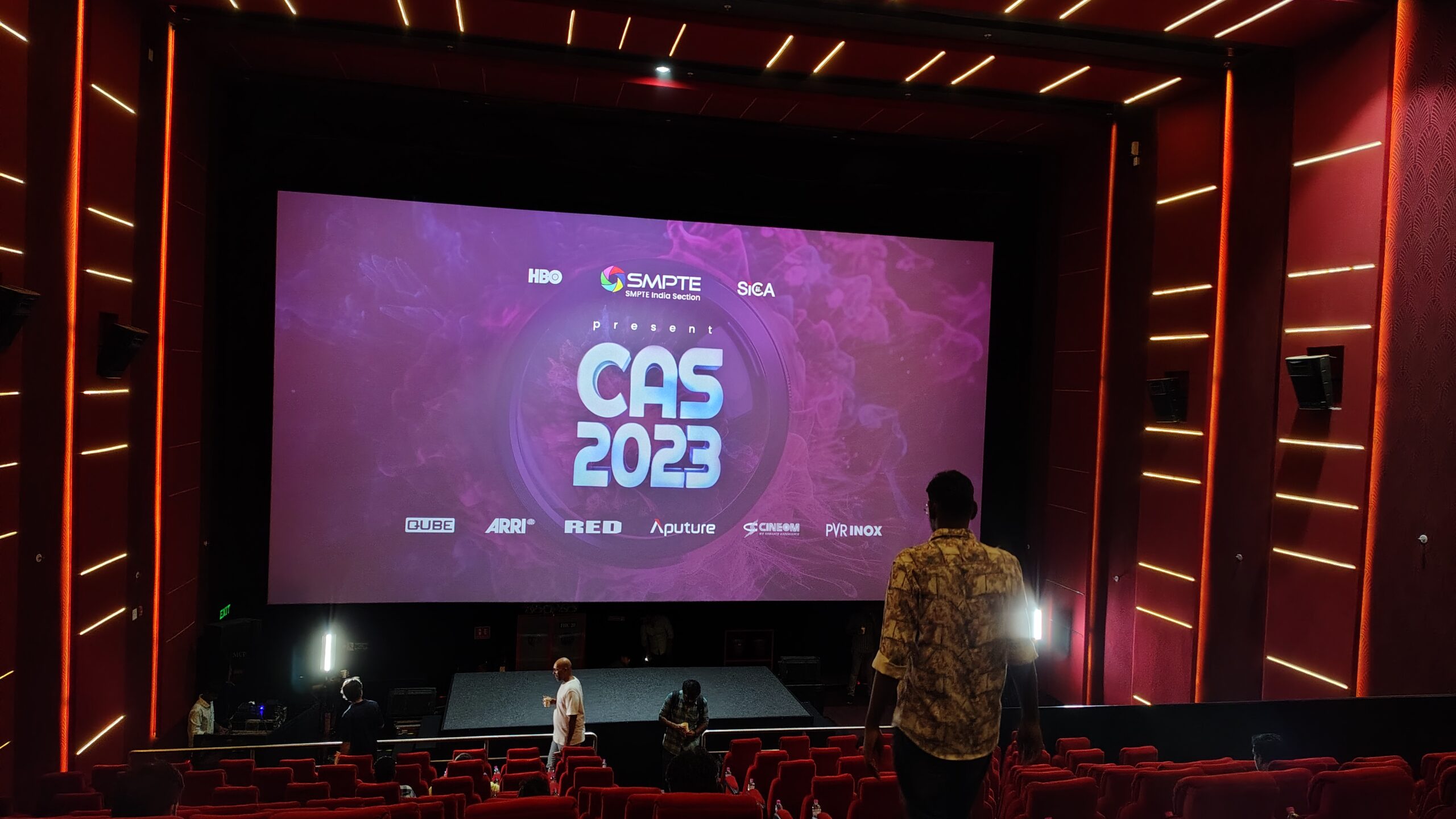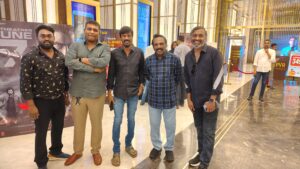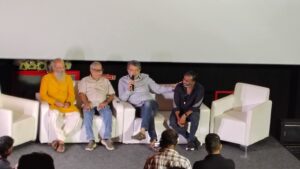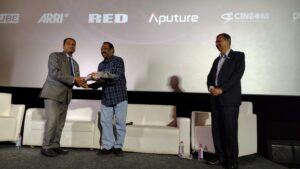
CAS 2023! Qube SICA SMPTE!!
Jun 09 2024
SICA Hosts First-Ever HBO Camera Assessment Series in India

The Southern Indian Cinematographers’ Association (SICA), in collaboration with Qube and SMPTE India, proudly hosted the first-ever HBO Camera Assessment Series (CAS) event in India. This prestigious event, popular in Hollywood for the past decade, took place at PVR Cinemas, VR Mall, Chennai, on Sunday, June 9th, at 9:30 am. Mr. Jayendra of Qube India facilitated the event’s arrival in India, with extensive preparations spearheaded by SICA Treasurer Sakthi Saravanan and Mr. Prabhu from Qube Real Image.




Panel Discussion Insights
The event featured a panel discussion with popular cinematographers Rajiv Menon, Manoj Paramahamsa, Nirav Shah, and former Prasad Lab General Manager of Operations, Sivaraman Sir. Each shared valuable insights:

Rajiv Menon
Spear headed the event with many insights into how Sensor have evolved over the years reflecting on format and also the emergence of staked Sensor.
He also complimented the visual scheme and filming method the rigs the follow ups of characters and particularly the focus of jumping character camera gliding follows into the under water where the focus is entirely different and difficult and seamless accuracy in the visuals.
Highlighted the importance of learning LUTs and the enhanced possibilities for skin tones with modern cameras, noting, “Cameras are better than human eyes.”
– Nirav Shah
– Emphasized that almost all cameras visual imagery are similar, with differences mainly at the edges. He reflected on the changing aesthetics from film to digital, stating, “Film look is a distant memory.”
Film look at that period was entirely different and challenging not the way now we see film look in Digital medium.
He also said challenge for cinematography are always there time to time like medium outside Mtv, sports visuals.
Manoj Paramahamsa
– Discussed the comprehensive feel of digital visuals, noting that digital provides a clear representation of what you see, whereas film captures elements unseen by the naked eye. He commented on the unique characteristics of each camera tested.
Overall the this event is to be heard through Sivaraman sir who had been showered with appreciation for his contribution for bringing consistency in image processing and printing.
Sivaraman on his own words about CAS 2023
CAS 23 BY HBO & SMPTE In association with Sica and Qube in Inox PVR VR Mall Chennai.
First of all I must thank SICA & QUBE for inviting me and asking me to be one of the panelists in the discussion and the Q&A session post screening.
It was a proud privilege and fantastic experience for me as an individual.
CAS 23 was an unique experience in Camera Assessment excercise. In the sense, usually we see the demo films produced by the Camera & film manufacturers. These demo films high lights the salient features of their product as a promotional and marketing initiatives. In the process sometimes the product features are tend to be exaggerated and the users are persuaded to make use of it for better results.
In this case HBO & SMPTE two independent professional bodies have made eloborate tests to analyse and asses the various professional motion picture digital cameras and Kodak 5219 film stock.
There are no recomedations. They have simply compared the results and presented the results in a spectacular manner. Which is the result of lot of planning, hard work and ofcourse money
The cameras were assessed for the resolution, sharpness, skin tones, performance in mixed colour situation, dynamic range , performance in available light condition, inflence of props and costumes on skin tone, elasticity beyond the dynamic range of 14 fstops up to 20 f stops. This means looking far deeper into shadow hither too not done. If course this means we need to pull those details out in the post production. Ofcourse this involves some trade of with grainess( noise) and loss of black..
Thus CAS presentation makes no judgement or recommendations. It simply paresents the various capabilities and merits of each Camera from most expensive to least expensive, Alexa Mini, Red Velocy raptor, Sone Venice-2, Arri Alexa 35 , and Black Magic ursa.
In my opinion this test is made to help the cinematographers who are the creators of the image and responsible for it to make informed decisions. This decision making will be influenced by the artistic , technical and aesthetic aspects of the image as demanded by the script. The look and tonality should help the story telling in the most effective manner is the bottom line.
In this context i thought I must answer few questions often asked by the students and young and aspiring film makers.
“What is film look” why great film makers like Christopher Nolan still prefer to shoot in film ( Analogue) what makes the difference between film and Digital image ?
For them I would say
1.film is organic. and Digital is synthetic
2.film is Animal + plant +Metal
Animal because gelatin which an organic substance derived from horns , hooves and skin of Cattle. Plant because the film based CTA ( Cellulose Tri Acetate ) is made from plant meterials like bamboo. Metal because the microscopic Siver halide crystals are metal. Hence there is some kind of life in it. Perhaps that is why people in the film making chain treat the film with more respect.
3.Another point in favour of film – film emulsion has more the 7 colour sensitve layers, which means it has more depth and dimensions compared to flat Digital mediu
4. In film the image sensors( microscopic silver halide crystels of various sizes are suspended in the emulsion in a” random fashion” which gives that beautiful smoothness to the image. On the other hand in Digital format the sensors( pixels) are arranged in fixed grid in rows and columns. Hence it may be cleaner, sharper and colourful but lacks in tonal qualities.
5.Another very important characteristic of film which is a limitation that gives images of artistic value is that , ” film is a threshold recoding device, which means that film require a certain minimum amount of light to expose. Where as Digital is a linear recording device. So the image is clean sterile and sharp but that sometimes is a minus aspect aesthetically.
6.Another important reason for cinematographers to respect film and people working in the filmlab is the emotional factory & human connection”.
As a lab man who has been handling film for more than five decades, my mind is tuned to the touch, feel and smell of the film. And the magnificent images produced by it on the screen excited me all the time.
Hence it is natural that my heart says, ” film is great”
But my mind says Digital is better, more efficient, more dynamics range, more cost effective. More than anything else it has expanded the horizon of new possibilities in imaging. So the days belong to Digital till such time new technologies like AR, VR,and AI takes over. Change is something that doesn’t change.
I must take this video opportunity to thank Rajiv Menon, Nirav Shah and Manoj Paramahamsa for expressing their appreciation for the lab work.
Concluded by Sivaraman sir.

Finally coming to the event out come
Advantages of the HBO Camera Assessment Series
1. Comprehensive Camera Evaluation:
– The series provides a detailed comparison of leading camera models, including the Arri Alexa mini ,Sony Venice 2, RED V-Raptor, ARRI Alexa 35, Blackmagic Ursa 12K and Kodak 5219 showcasing their strengths and weaknesses.
2. Advanced Testing Methodology
– Utilizes the Academy Color Encoding System (ACES) for consistent color space and grading, ensuring accurate sensor performance analysis.
3. Real-World Scenarios
– Unlike traditional tests with static charts, the series employs staged scenes with moving cameras and actors, replicating real production environments.
4. Dynamic Range and Color Accuracy:
– Tests include dynamic range and color rendering assessments, crucial for HDR and low-light shooting, highlighting differences in signal-to-noise ratios and color fidelity.
5. Educational Value:
-the series offers valuable insights into the latest advancements in digital cinematography, benefiting both professionals and students.
6. Industry Collaboration
– Encourages collaboration and discussion among studios and creative teams, aiding in the development of visual language and aesthetic decisions for new projects.
7. Continuous Innovation
– Reflects ongoing technological advancements, adapting tests to address emerging issues and standards in digital cinematography, making it a relevant resource for current and future trends.
Reflections on Film vs. Digital
Conclusion
The CAS 2023 event, organized by SICA and Qube, marks a significant milestone in bringing high-level camera assessments to the Indian cinematography community, fostering knowledge and technological growth. Special thanks to Mr. Jayendra for his efforts in facilitating this landmark event. SMPTE India’s Ujwal N Nirgudkar also expressed readiness to provide knowledge support to film students, enhancing the educational impact of this initiative.

SICA President Karthik Raaja was called upon the stage and honoured with other dignitaries who were behind this show.
Article by
CJ Rajkumar
Author/ Cinematographer
